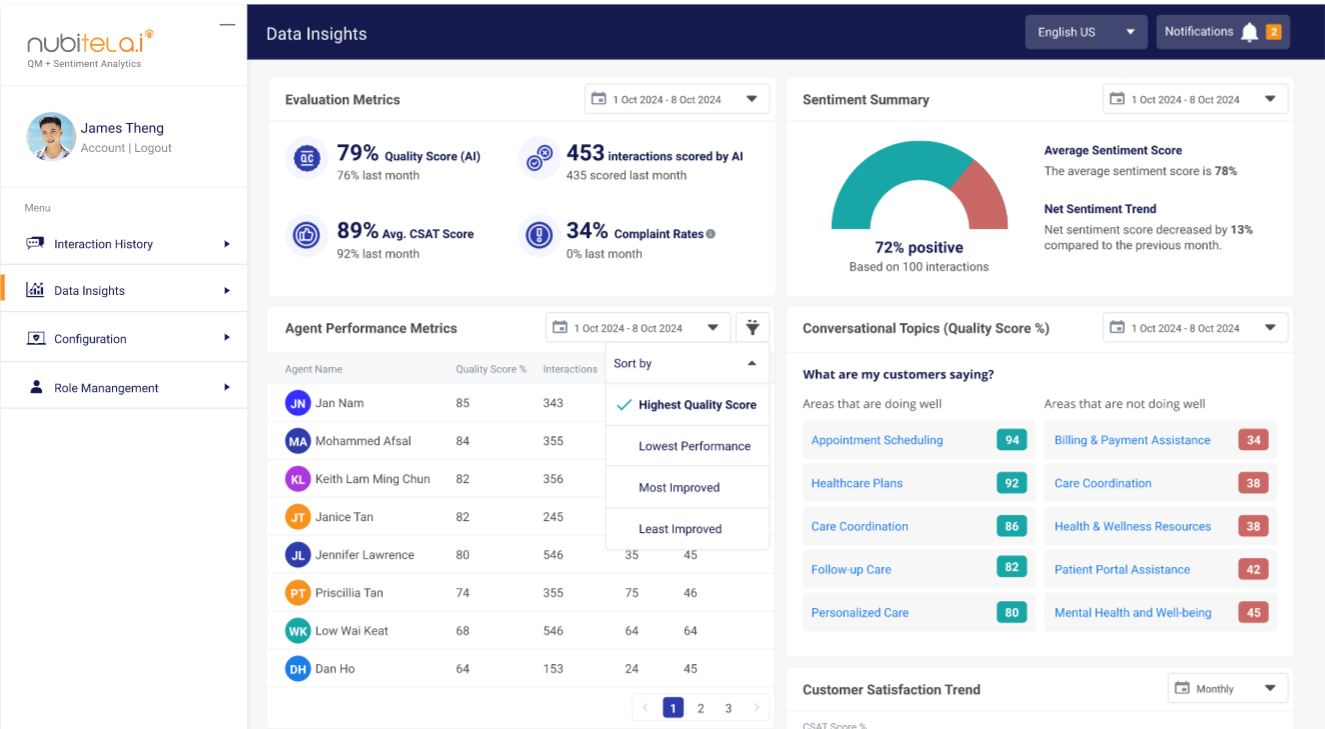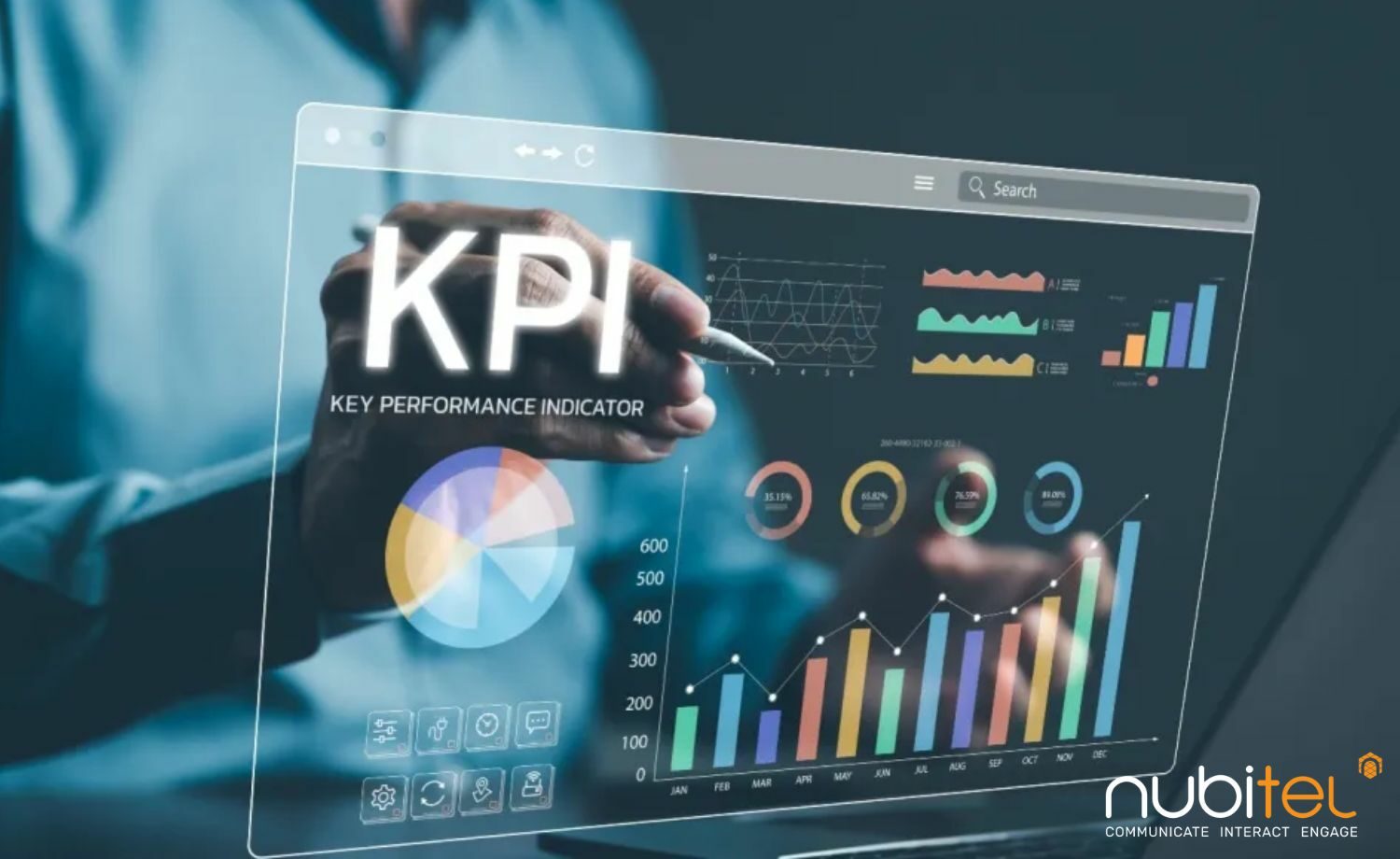Effective call center management hinges on tracking the right call center KPIs to enhance customer satisfaction and operational efficiency. By focusing on key metrics, businesses can empower their teams, streamline processes, and create exceptional customer experiences. When properly monitored, call center KPIs enable organizations to identify areas for improvement, drive better performance, and ultimately foster customer loyalty and growth.
In this article, we will explore how tracking and optimizing call center KPIs can help improve overall performance and deliver a superior customer experience.
Table of Contents
ToggleWhat Are Call Center KPIs?
Call Center KPIs are measurable metrics used to assess a contact center’s performance in fulfilling business goals. These indicators are critical for evaluating customer service quality, operational efficiency, and agent productivity.
By effectively tracking KPIs, businesses can make data-driven decisions that enhance service delivery, optimize resource allocation, and streamline operations.
Importance of Tracking Call Center KPIs
By tracking key performance indicators (KPIs), call centers can align their goals with the larger objective of enhancing service quality and operational performance. These metrics offer invaluable insights to allow managers to make data-driven decisions and continuously improve service standards.
Enhancing Customer Satisfaction
Customer satisfaction is the cornerstone of any high-performing call center. KPIs such as Customer Satisfaction Score (CSAT) and First Call Resolution (FCR) provide direct insight into how well customer needs are met. A high CSAT score, for example, reflects that customers are consistently satisfied with the service they receive. By ensuring timely issue resolution, personalized interactions, and efficient processes, call centers can boost customer happiness and loyalty.
In addition, optimizing Average Handle Time (AHT) without sacrificing service quality is essential for improving CSAT. Statista reports that customers who have exceptional service experiences are 140% more likely to increase their spending compared to those who have less favorable interactions. This reinforces the strong link between delivering quality service and driving long-term customer loyalty.
Enhancing Agent Performance
Call center agents play a crucial role in delivering high-quality customer service and maintaining satisfaction levels. Key performance indicators (KPIs) such as Average Handle Time (AHT), Abandonment Rate, and First Call Resolution (FCR) help assess agent efficiency and effectiveness. For instance, a high FCR rate indicates that agents are resolving customer issues on the first interaction, reducing repeat calls and improving customer experience.
Consistently tracking these KPIs allows managers to pinpoint skill gaps and provide targeted training and coaching. With 31% of customers valuing knowledgeable agents as key to a positive experience, investing in continuous training ensures agents are equipped to handle inquiries effectively. Companies that implement regular coaching programs see a 20-30% boost in agent productivity and job satisfaction, leading to better performance and lower turnover rates.
Driving Operational Efficiency
Operational efficiency is a crucial aspect of balancing service quality with cost management in call centers. KPIs like Service Level, Forecasting Accuracy, and Cost Per Call provide critical insights into operational performance. For instance, maintaining a service level of answering 80% of calls within 20 seconds is a widely accepted industry benchmark that ensures prompt service while minimizing delays.
Efficient resource management and accurate forecasting are key drivers of operational efficiency. Additionally, implementing advanced technologies like AI and automation can streamline workflows and reduce manual labor, allowing agents to focus on complex customer interactions.
Essential Call Center KPIs You Should Know
Tracking the right KPIs ensures a call center operates efficiently and meets customer expectations. Below, we examine key metrics that influence performance and decision-making.
- First Call Resolution (FCR): FCR measures the percentage of customer issues resolved on the first contact, without requiring follow-ups. A high FCR rate reduces call volumes and enhances customer satisfaction. Best practices for improving FCR include providing comprehensive agent training and using AI-driven knowledge bases to assist with complex queries.
- Average Handle Time (AHT): AHT calculates the total time spent on a call, including talk time, hold time and after-call work. While shorter AHT often indicates efficiency, reducing it excessively can compromise service quality. To optimize AHT, call centers should implement automation tools and provide agents with real-time customer insights.
- Customer Satisfaction Score (CSAT): CSAT is typically measured through post-call surveys where customers rate their experience. A high CSAT score signifies effective service delivery. Strategies for improving CSAT include personalized customer interactions, reduced wait times, and proactive problem resolution.
- Service Level: Service Level is a critical KPI that measures the percentage of calls answered within a specified time frame. Maintaining an optimal service level requires accurate call forecasting, workforce planning, and effective queue management to minimize wait times.
- Abandonment Rate: This metric tracks the percentage of customers who hang up before reaching an agent. High abandonment rates often indicate long wait times or ineffective IVR systems. To lower abandonment rates, businesses should optimize staffing levels and enhance self-service options.
How to Measure Call Center KPIs Effectively
Accurate measurement of call center KPIs requires a structured approach and data-driven strategies. Under this, we explore key methods to ensure effective tracking and optimization.
Leveraging the Right Tools
Tracking key performance indicators (KPIs) effectively requires leveraging AI-driven conversation analytics to gain actionable insights into customer interactions and agent performance. These tools analyze call quality, sentiment trends, and customer concerns, providing real-time data to enhance decision-making.

For example, AI-powered quality scoring evaluates interactions based on predefined criteria, ensuring consistent service standards. Sentiment analysis tracks customer emotions, helping businesses understand satisfaction levels and address pain points.
Additionally, automated topic analysis identifies areas where agents excel, such as appointment scheduling, and areas needing improvement, like billing and payment assistance.
Setting Realistic Targets
Setting achievable and meaningful KPI benchmarks is critical to maintaining agent morale and operational success. Targets should be grounded in historical data, industry standards, and the specific goals of the business.
Unrealistic KPI targets can lead to agent burnout, frustration, and a decline in service quality. In contrast, well-structured, attainable goals foster motivation and consistent performance, driving continuous improvements over time.
Regular Monitoring and Analysis
Ongoing KPI tracking ensures call centers stay on course to meet their performance objectives. Consistent analysis—whether through weekly or monthly reviews—helps managers identify emerging trends, recognize areas of underperformance, and proactively address challenges. Timely intervention allows for swift resolution of issues and sustained service excellence.
Challenges in Managing Call Center KPIs
Managing call center KPIs comes with various obstacles that can impact performance and decision-making. Below, we examine common challenges and their implications.
Data Management Issues
Managing and analyzing large volumes of KPI data can be a significant challenge for call centers. Without proper tools and systems in place, the complexity and volume of data can become overwhelming, leading to inefficiencies and missed insights. Implementing automated reporting and data analytics tools can streamline this process, ensuring data is organized, easy to interpret, and actionable.
Undefined Goals
Without clear and measurable KPI objectives, call centers can struggle to maintain consistent performance measurement. Vague or poorly defined targets often result in misaligned efforts and confusion.
Setting specific, measurable, achievable, relevant, and time-bound (SMART) goals that are aligned with broader business objectives is essential for driving meaningful performance improvement.
Lack of Agent Training
Even the best KPIs won’t drive results if agents are not adequately trained to meet them. Lack of training can lead to confusion, inefficiency, and poor performance, which directly affects customer satisfaction and operational goals.
Ongoing training programs, tailored to address skill gaps, empower agents to perform their best and reach their KPI targets, improving both agent satisfaction and customer service.
Best Practices for Optimizing Call Center KPIs
To effectively optimize call center KPIs, it’s essential to integrate a combination of strategic practices that focus on agent development, technological adoption, and continuous improvement.
These best practices help not only in enhancing operational efficiency but also in ensuring that call centers remain adaptable and responsive to customer demands and business objectives.
Effective Coaching and Feedback
Regular coaching and feedback are key to improving agent performance. Constructive, data-driven feedback based on KPI insights helps agents understand where they excel and where improvement is needed. By providing tailored feedback and actionable advice, managers can empower agents to develop their skills, which leads to better individual performance and a stronger overall team.
Investing in Technology
Adopting advanced technologies, such as AI-powered analytics, chatbots, and cloud-based systems, significantly enhances the accuracy and efficiency of KPI tracking. These technologies not only streamline workflows but also enable managers to make real-time adjustments, ensuring KPIs are continuously aligned with evolving business needs.
Continuous Process Improvement
To maintain competitive advantage, it’s crucial for call centers to consistently review and refine their processes. This includes regularly assessing operational workflows, adapting to new industry trends, and implementing best practices. Continuous process improvement ensures long-term success by enabling call centers to stay agile and responsive to both customer needs and market changes.
Selecting the Right KPIs for Your Call Center
When it comes to call center KPIs, it’s essential to focus on the metrics that truly drive performance for your call center. Choosing the right KPIs ensures that your operations run smoothly, your agents stay motivated without being overburdened, and your customers receive the reliable service they expect.
At Nubitel, we help you track the key metrics that matter most to your business, ensuring no important data slips through the cracks.
Pick the KPIs that align with your goals, and let’s start optimizing your performance!





